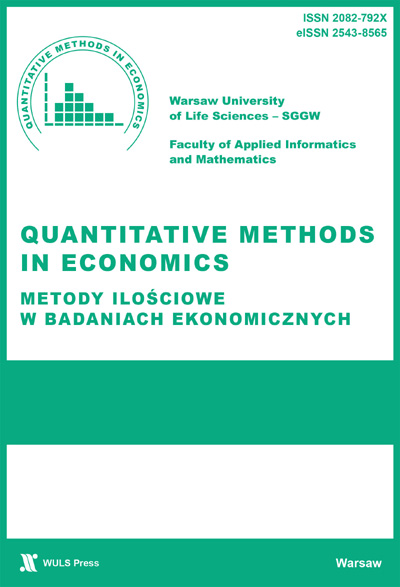Main Article Content
Article Details
Adamowicz E., Walczyk K. (2018) Koniunktura w przemyśle. Luty 2018. Badanie okresowe nr 353. Instytut Rozwoju Gospodarczego (RIED), SGH Warsaw School of Economics (in Polish).
Bańkowska K., Osiewicz M., Pérez-Duarte S. (2015) Measuring Non-Response Bias in a Cross-Country Enterprise Survey. European Central Bank Statistics Paper Series, 12. (Crossref)
Białowolski P., Dudek S., Kowalczyk B. (2005) Analiza zwrotności w badaniach konsumenckich oraz próby poprawiania reprezentatywności na przykładzie badania kondycji gospodarstw domowych. Prace i Materiały Instytutu Rozwoju Gospodarczego (RIED), 76, SGH Warsaw School of Economics (in Polish).
Brick J. M., Tourangeau R. (2017) Responsive Survey Designs for Reducing Nonresponse Bias. Journal of Official Statistics, 33(3), 735-752 [http://dx.doi.org/10.1515/JOS-2017-0034]. (Crossref)
Calinescu M., Schouten B. (2016) Adaptive Survey Designs for Nonresponse and Measurement Error in Multi-Purpose Surveys. Survey Research Methods, 10(1) [https://ojs.ub.uni-konstanz.de/srm/article/view/6157].
Cobben F. (2009) Nonresponse in Sample Surveys: Methods for Analysis and Adjustment. Statistics Netherlands, The Hague [www.cbs.nl].
Curtin R., Presser S., Singer E. (2005) Changes In Telephone Survey Nonresponse Over The Past Quarter Century. The Public Opinion Quarterly, 69, 87-98. (Crossref)
Czajka J. L., Beyler A. (2016) Declining Response Rates in Federal Surveys: Trends and Implications. Mathematica Policy Research, Final Report, 1.
Drozdowicz-Bieć M. (2012) Cykle i wskaźniki koniunktury. Wydawnictwo Poltext, Warszawa (in Polish).
Dudek S. (2017) Kondycja gospodarstw domowych. IV kwartał 2017. Badanie okresowe nr 101. Instytut Rozwoju Gospodarczego (RIED), SGH Warsaw School of Economics (in Polish).
Dudek S., Zając T. (2012) Zastosowanie modeli czynnikowych do konstrukcji barometru koniunktury na podstawie badań ankietowych. Prace i Materiały Instytutu Rozwoju Gospodarczego (RIED), 90, SGH Warsaw School of Economics (in Polish).
Gradzewicz M., Growiec J., Hagemejer J., Popowski P. (2010) Cykl koniunkturalny w Polsce – wnioski z analizy spektralnej. Bank i Kredyt, 41(5), 41-76 (in Polish).
Kowalczyk B., Tomczyk E. (2009) Survey Non-Response and Properties of Expectations of Industrial Enterprises – Analysis Based on Business Tendency Surveys. [in:] Wywiał K., Żądło T. (Eds.) Survey Sampling in Economic and Social Research. 4, 42-59.
Lynn P. (2017) From Standardised to Targeted Survey Procedures for Tackling Non-Response and Attrition. Survey Research Methods, 11(1), 93-103 [doi:10.18148 /srm/2017.v11i1.6734].
Phillips A. W., Reddy S., Durning S. J. (2016) Improving Response Rates and Evaluating Nonresponse Bias in Surveys: AMEE Guide No. 102. Medical Teacher, 38(3), 217-228. (Crossref)
Platek R. (1977) Some Factors Affecting Non-Response. Paper Presented at the 41st Session of the International Statistical Institute, New Delhi, 5-15.
Rassmusen K., Thimm H. (2009) Fact-Based Understanding of Business Survey Non-Response. The Electronic Journal of Business Research Methods, 7(1), 83-92.
Seiler C. (2010): Dynamic Modelling of Nonresponse in Business Surveys. IFO Working Paper 93 [www.cesifo-group.de].
Thompson K., Oliver B. (2012) Response Rates in Business Surveys: Going Beyond the Usual Performance Measure. Journal of Official Statistics, 28(2), 221-237.
Toepoel V., Schonlau M. (2017) Dealing with Nonresponse: Strategies to Increase Participation and Methods for Postsurvey Adjustments. Mathematical Population Studies, 24(2), 79-83 [https://doi.org/10.1080/08898480.2017.1299988]. (Crossref)
Tomczyk E. (2018) To be (Accounted for) or not to be: Factors Influencing Probability of Non-Response in Economic Tendency Surveys. Prace i Materiały Instytutu Rozwoju Gospodarczego (RIED), 100, SGH Warsaw School of Economics.
Wittwer R., Hubrich S. (2015) Nonresponse in Household Surveys: A Survey of Nonrespondents from the Repeated Cross-Sectional Study ”Mobility in Cities – SrV” in Germany. Transportation Research Procedia, 11, 66-84. (Crossref)
Downloads
- Emilia Tomczyk, ZASTOSOWANIE INDEKSÓW SIŁY W ANALIZIE STRUKTURY WŁASNOŚCIOWEJ SEKTORA BADAWCZO-ROZWOJOWEGO , Metody Ilościowe w Badaniach Ekonomicznych: Tom 19 Nr 3 (2018)
- Emilia Tomczyk, DATA VINTAGE IN TESTING PROPERTIES OF EXPECTATIONS , Metody Ilościowe w Badaniach Ekonomicznych: Tom 16 Nr 2 (2015)

Utwór dostępny jest na licencji Creative Commons Uznanie autorstwa – Użycie niekomercyjne 4.0 Międzynarodowe.
Publikowane artykuły dostępne są na warunkach Open Access na zasadach licencji Creative Commons CC BY-NC – do celów niekomercyjnych udostępnione materiały mogą być kopiowane, drukowane i rozpowszechniane. Autorzy ponoszą opłatę za opublikowanie artykułu.





